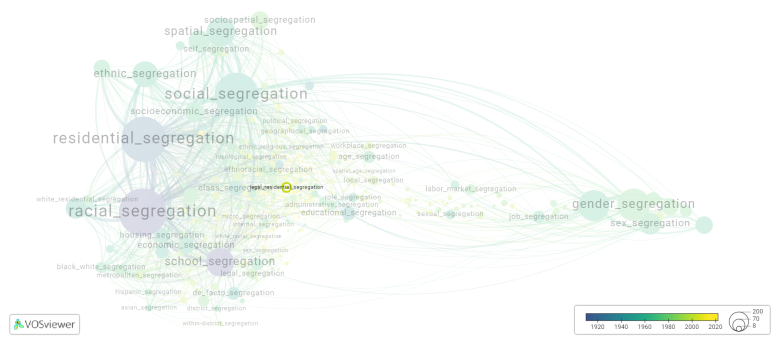Legal residential segregation: Difference between revisions
(Creating page) |
(Creating page) |
||
| (9 intermediate revisions by the same user not shown) | |||
| Line 1: | Line 1: | ||
===== Date and country of first publication<ref>Date and country of first publication as informed by the Scopus database (December 2023).</ref>===== | |||
2014<br> | 2014<br> | ||
France | |||
===== Definition ===== | |||
Legal residential segregation refers to the systematic separation of individuals or communities along racial, ethnic, or socioeconomic lines through policies, laws, or regulations enacted by governmental bodies or institutions. This segregation has historically been enforced through various means, such as racial zoning laws, restrictive covenants, redlining, and discriminatory lending practices. | |||
In the United States, for example, legal residential segregation was prevalent during the Jim Crow era, when laws were enacted to enforce racial segregation in housing, education, and public facilities. These laws and policies often restricted where people of different racial or ethnic backgrounds could live, resulting in the creation of racially segregated neighborhoods and communities. | |||
Although many of the explicit legal mechanisms of residential segregation have been abolished, its effects persist due to ongoing systemic inequalities and discriminatory practices in housing and lending. For instance, redlining, which involved the denial of mortgage loans or insurance to residents of certain neighborhoods based on their racial composition, has had long-lasting effects on patterns of residential segregation in many urban areas. | |||
Efforts to address legal residential segregation often involve promoting fair housing policies, enforcing anti-discrimination laws, expanding access to affordable housing, and addressing systemic barriers to housing equity. These efforts aim to create more inclusive and equitable communities where individuals of all backgrounds have equal access to housing opportunities and resources. | |||
==See also== | |||
==Related segregation forms== | |||
Legal residential segregation is frequently discussed in the literature with the following segregation forms: | |||
[[residential segregation]] | |||
[[File:legal_residential_segregation.png|780x780px]] | |||
This visualization is based on the study [[Segregation_Wiki:About| The Multidisciplinary Landscape of Segregation Research]]. | |||
For the complete network of interrelated segregation forms, please refer to: | |||
* [https://tinyurl.com/2235lkhw First year of publication] | |||
* [https://tinyurl.com/2d8wg5n3 Louvain clusters] | |||
* [https://tinyurl.com/223udk5r Betweenness centrality] | |||
* [https://tinyurl.com/244d8unz Disciplines in which segregation forms first emerged (Scopus database).] | |||
==References== | ==References== | ||
== | ==Notes== | ||
<references /> | |||
{{NoteAI}} | |||
==Legal residential segregation appears in the following literature== | |||
Coquery-Vidrovitch C. (2014) | Coquery-Vidrovitch C. (2014). From residential segregation to African urban centres: City planning and the modalities of change in Africa south of the Sahara. ''Journal of Contemporary African Studies'', ''32''(1), 1-12. Routledge.https://doi.org/10.1080/02589001.2014.900307 | ||
Latest revision as of 07:17, 16 October 2024
Date and country of first publication[1][edit | edit source]
2014
France
Definition[edit | edit source]
Legal residential segregation refers to the systematic separation of individuals or communities along racial, ethnic, or socioeconomic lines through policies, laws, or regulations enacted by governmental bodies or institutions. This segregation has historically been enforced through various means, such as racial zoning laws, restrictive covenants, redlining, and discriminatory lending practices.
In the United States, for example, legal residential segregation was prevalent during the Jim Crow era, when laws were enacted to enforce racial segregation in housing, education, and public facilities. These laws and policies often restricted where people of different racial or ethnic backgrounds could live, resulting in the creation of racially segregated neighborhoods and communities.
Although many of the explicit legal mechanisms of residential segregation have been abolished, its effects persist due to ongoing systemic inequalities and discriminatory practices in housing and lending. For instance, redlining, which involved the denial of mortgage loans or insurance to residents of certain neighborhoods based on their racial composition, has had long-lasting effects on patterns of residential segregation in many urban areas.
Efforts to address legal residential segregation often involve promoting fair housing policies, enforcing anti-discrimination laws, expanding access to affordable housing, and addressing systemic barriers to housing equity. These efforts aim to create more inclusive and equitable communities where individuals of all backgrounds have equal access to housing opportunities and resources.
See also[edit | edit source]
Related segregation forms[edit | edit source]
Legal residential segregation is frequently discussed in the literature with the following segregation forms:
This visualization is based on the study The Multidisciplinary Landscape of Segregation Research.
For the complete network of interrelated segregation forms, please refer to:
References[edit | edit source]
Notes[edit | edit source]
- ↑ Date and country of first publication as informed by the Scopus database (December 2023).
At its current state, this definition has been generated by a Large Language Model (LLM) so far without review by an independent researcher or a member of the curating team of segregation experts that keep the Segregation Wiki online. While we strive for accuracy, we cannot guarantee its reliability, completeness and timeliness. Please use this content with caution and verify information as needed. Also, feel free to improve on the definition as you see fit, including the use of references and other informational resources. We value your input in enhancing the quality and accuracy of the definitions of segregation forms collectively offered in the Segregation Wiki ©.
Legal residential segregation appears in the following literature[edit | edit source]
Coquery-Vidrovitch C. (2014). From residential segregation to African urban centres: City planning and the modalities of change in Africa south of the Sahara. Journal of Contemporary African Studies, 32(1), 1-12. Routledge.https://doi.org/10.1080/02589001.2014.900307

